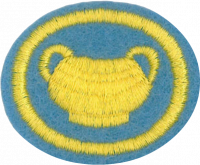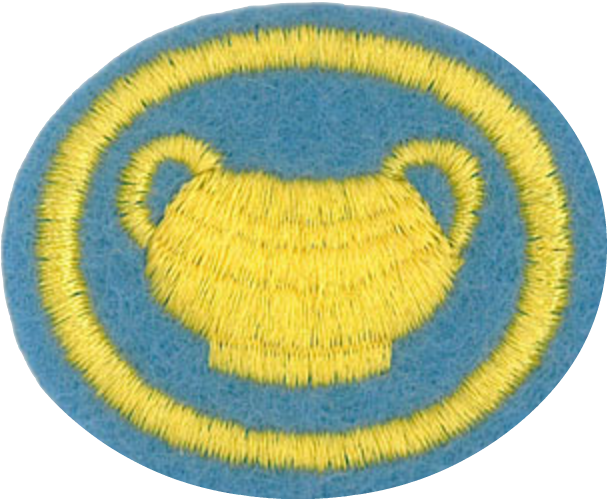Difference between revisions of "AY Honors/Pottery/Answer Key"
Jomegat bot (talk | contribs) (Bot: Automated import of articles *** existing text overwritten ***) |
m |
||
| Line 3: | Line 3: | ||
{{ansreq|page={{#titleparts:{{PAGENAME}}|2|1}}|num=1}} | {{ansreq|page={{#titleparts:{{PAGENAME}}|2|1}}|num=1}} | ||
<noinclude><translate></noinclude> | <noinclude><translate></noinclude> | ||
| − | <!-- 1. Write or explain orally the different types and uses of pottery and the materials used in making it. | + | <!-- 1. Write or explain orally the different types and uses of pottery and the materials used in making it. --> |
<noinclude></translate></noinclude> | <noinclude></translate></noinclude> | ||
{{CloseReq}} <!-- 1 --> | {{CloseReq}} <!-- 1 --> | ||
| Line 10: | Line 10: | ||
<!-- 2. What is the purpose of a glaze? Describe the specific dangers to be avoided. --> | <!-- 2. What is the purpose of a glaze? Describe the specific dangers to be avoided. --> | ||
===Purpose=== | ===Purpose=== | ||
| − | Glaze is a glassy coating which is fired to make it fuse to a ceramic object in order to color, decorate, strengthen or waterproof it. | + | Glaze is a glassy coating which is fired to make it fuse to a ceramic object in order to color, decorate, strengthen or waterproof it. Glazing is functionally important for earthenware vessels, which would otherwise be unsuitable for holding liquids due to porosity. Glaze is also used on functional and decorative stoneware and porcelain. In addition to the functional aspect of glazes, aesthetic concerns include a variety of surface finishes, including degrees of gloss and matte, variegation and finished color. Glazes may also enhance an underlying design or texture which may be either the "natural" texture of the clay or an inscribed, carved or painted design. |
===Dangers=== <!--T:2--> | ===Dangers=== <!--T:2--> | ||
| Line 19: | Line 19: | ||
{{ansreq|page={{#titleparts:{{PAGENAME}}|2|1}}|num=3}} | {{ansreq|page={{#titleparts:{{PAGENAME}}|2|1}}|num=3}} | ||
<noinclude><translate></noinclude> | <noinclude><translate></noinclude> | ||
| − | <!-- 3. Design and draw two pottery forms, one of which must be decorated. | + | <!-- 3. Design and draw two pottery forms, one of which must be decorated. --> |
<noinclude></translate></noinclude> | <noinclude></translate></noinclude> | ||
{{CloseReq}} <!-- 3 --> | {{CloseReq}} <!-- 3 --> | ||
{{ansreq|page={{#titleparts:{{PAGENAME}}|2|1}}|num=4}} | {{ansreq|page={{#titleparts:{{PAGENAME}}|2|1}}|num=4}} | ||
<noinclude><translate></noinclude> | <noinclude><translate></noinclude> | ||
| − | <!-- 4. Do three of the following. Each project is to be decorated, such as painted, glazed, or indented: | + | <!-- 4. Do three of the following. Each project is to be decorated, such as painted, glazed, or indented: --> |
<noinclude></translate></noinclude> | <noinclude></translate></noinclude> | ||
{{ansreq|page={{#titleparts:{{PAGENAME}}|2|1}}|num=4a}} | {{ansreq|page={{#titleparts:{{PAGENAME}}|2|1}}|num=4a}} | ||
Revision as of 18:28, 6 May 2021
1
2
Purpose
Glaze is a glassy coating which is fired to make it fuse to a ceramic object in order to color, decorate, strengthen or waterproof it. Glazing is functionally important for earthenware vessels, which would otherwise be unsuitable for holding liquids due to porosity. Glaze is also used on functional and decorative stoneware and porcelain. In addition to the functional aspect of glazes, aesthetic concerns include a variety of surface finishes, including degrees of gloss and matte, variegation and finished color. Glazes may also enhance an underlying design or texture which may be either the "natural" texture of the clay or an inscribed, carved or painted design.
Dangers
Many of the ceramic glazes contain lead. Because of this, lead-based glaze should not be used on articles intended for use in eating or drinking.
3
4
4a
4b
4c
4d
4e
4f


